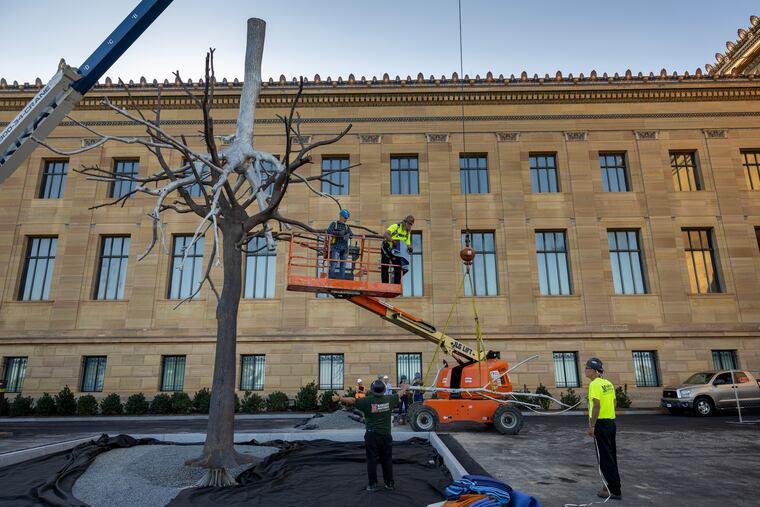Exhibition at Philadelphia Museum of Art explores Giuseppe Penone’s lifelong love affair with trees
The international spotlight is shining on the Italian artist, who has major exhibitions at the PMA, the Pompidou Centre in Paris, and the ancient Baths of Caracalla in Rome.

Rising to the left of the west entrance to the Philadelphia Museum of Art is a tree.
But this is no ordinary tree. In fact, it is two dead trees, represented by casts, one atop the other, the whole crowned with roots, also cast.
The tree soars 40 feet into the air, rising from a base trunk of bronze, which meets and intertwines with an inverted top of lighter, shimmering aluminum. Mirrors blossom from the upper branches. The whole is crowned with roots, reaching skyward.
This sculpture, called Identità by sculptor Giuseppe Penone, was crafted to mark the opening of “River of Forms: Giuseppe Penone’s Drawings,” an exhibition of over 200 drawings, plus a dozen sculptures, and 21 etchings and other objects. The show opens Saturday for a run through Feb. 26.
In 2020, the artist gave 309 drawings and works on paper to the PMA. At the same time, he gave 328 drawings to the Pompidou Centre in Paris. Both the PMA and the Pompidou are welcoming the gift with major exhibitions. The show at the Pompidou opens in October.
Penone also currently has a highly unusual exhibition mounted in the ancient Baths of Caracalla in Rome. Open until the end of October, the show, dubbed Idee di pietra (Stone Ideas), consists of four bronze trees — Identity, Triplex, Ideas of Stone — Elm and Ideas of Stone — Cherry — installed within the ruins, inviting visitors to reflect on the emblematic relationship between man and nature, space and time, as the curators put it.
Penone, now 75 and producing sculptures and other artworks since the 1960s, is at last finding the transcontinental spotlight focusing brightly on his efforts. It is about time, says Carlos Basualdo, the PMA’s curator of contemporary art, and the man responsible for introducing Penone to Philadelphia.
In Basualdo’s view, Penone is “one of the most important sculptors” working now anywhere in the world.
“He has been a powerful influence for generations of artists,” Basualdo said in a recent interview. “I have to say that I feel so honored that his work is here. The fact that he’s not that well-known here, in a way we’re kind of introducing him.”
But the fact that Penone’s stature and influence are so great in Europe and elsewhere, Basauldo says, makes presenting him in the United States feel a bit like “introducing James Bond translated into Spanish.”
Penone, who will be in Philadelphia for the opening of the exhibition, hails from Italy’s Piedmont, a region in northwestern Italy, surrounded by the Alps. It is a forested, mountainous geography that has had a profound influence on his artwork, driving him to create his earliest works literally in the woodlands around the rural town of Garessio, where he grew up.
“A tree is a sculpture itself,” says Basualdo. “A sculpture in time. But you could model the shape of a tree by intervening in different ways. He’s showing that if you always hold the tree like that, the tree would grow around you. And he actually cast his hand in bronze and held the tree and I saw the tree now.”
The sculpture seems set, says Basauldo, but it is in motion. “He’s saying, ‘We can see it as static, but we are part of a dynamic flow.’”
“enveloped by the skull and hidden from view spring the thoughts and impulses necessary to life ceaseless and endless,” Penone writes in his essay, Thoughts and Sap (Pensieri e linfa), included in the exhibition catalog. “they intertwine like roots have a trunk that is the central idea continuing down to the crown and taproot and the taproot divides into secondary roots and rootlets branching from the central idea into the details making up this idea down to the forks and nuances that complete its meaning and in the roots lie the thoughts of the tree they are its thinking organ its very own brain composed of a cortex, epidermis and hairs that increase its surface like cerebral folds and link it and hook it to the earth’s elements just as our thoughts guide us and engage with the environment around us and show the conditions necessary to live and move through space …”
This essay is a lyrical exposition on the relationship between the world of the tree in nature, made by nature, and the world of the tree as created or recreated in art.
Making the link between his art and the natural world even more explicit, Penone has brought his essay, literally, into the exhibition in the form of a mammoth scroll, perhaps as delicate and tradition-bound as any Chinese scroll. It is as difficult to escape the imperatives of form — whether they are historical or biological.
Thoughts and Sap as a work of art is an extended rubbing on linen of an acacia tree across the handwritten text of Thoughts and Sap. It stretches for 88 feet along a wall of the corridor approaching the exhibition galleries.
“What we’re doing is a show that is about the drawings but also could serve as an introduction for the American audiences about his work,” says Basualdo. “The beauty is that the work is all about our relationship to nature. And the fact that we are not different. We are part of nature. The forms that you find in nature are the forms that you find in the human body. I call it a river of forms that goes through all different realms.”